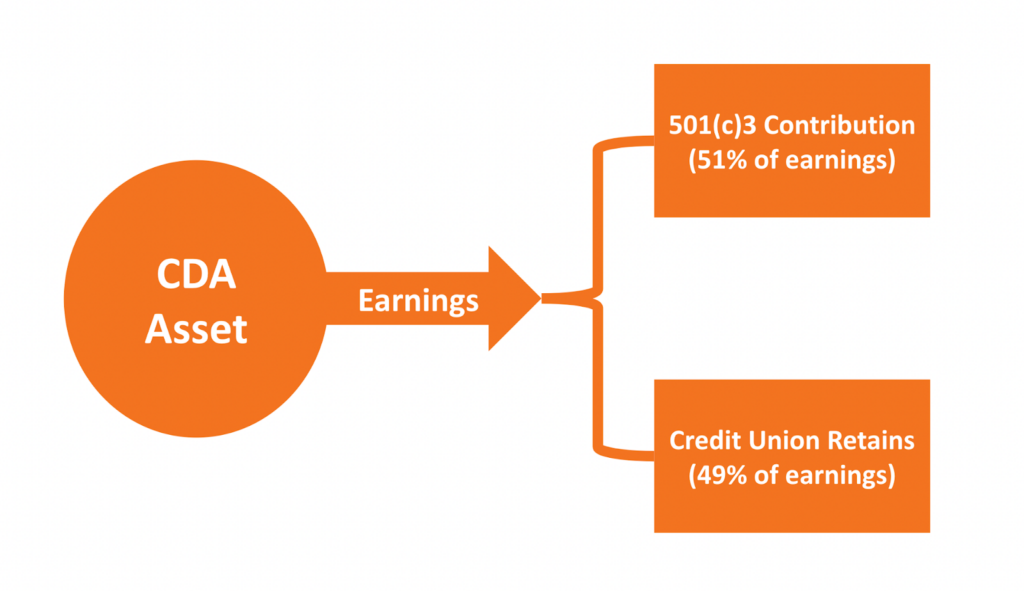Did you know individuals are 88% more loyal to a company that supports social or environmental issues?*
As a credit union, your mission to help people is an integral part of your establishment. Looking back on the past two years and the wide range of challenges that your community has faced, it’s especially important to do all you can to fulfill your mission as a credit union: People helping people. It’s the credit union way!
With this mission in mind, you may be able to do a tremendous amount more for the members of your community than you already are. How can your credit union make an even bigger difference in your community? Today, let’s talk about how you can use CDAs.

How Can CDAs Help Your Community?
Credit unions often face the balancing act of being actively accountable to their members while also utilizing the best investment strategies for their bottom line. The solution, in many cases, can be a charitable donation account (CDA).
A charitable donation account (CDA), according to Title 12, Section 721.2(b)(2), “is a hybrid charitable and investment vehicle… that you may fund as a means to provide charitable contributions and donations to qualified charities.”
The CDA is a power, authorized by both the Federal Credit Union Act and many states, that allows a credit union to invest in potentially higher-earning assets in order to help fund charitable giving to 501(c)3 organizations while maintaining or enhancing the credit union’s bottom line. – in short, a true win-win – both the charity (or charities and the credit union benefit).
We know that credit unions continually work to make a difference in their communities. This is evident through their support of financial education programs, including:
- The National Credit Union Foundation
- Local food banks
- Children’s Miracle Network
- The United Way
- Other local issues important to your community
Implementing a CDA, however, allows credit unions to optimize investment opportunities beyond traditional options.
Based on our calculations, credit unions can provide their communities with $100 to $200 million of additional funding, without any effect on their bottom line.
The Benefits
Consider the benefits of implementing a CDA to improve your bottom line while increasing member loyalty.
CDAs can help you demonstrate your:
- Values
- Commitment to your community
- Mission
By supporting causes important to your community and members, you are demonstrating your commitment beyond making loans and paying great deposit rates.
Additionally, the causes that you support allow members to be proud of their affiliation with your credit union. After all, research shows that consumers are 90% more likely to trust (and even switch to) organizations that support social issues.
When you take these statistics into consideration, the time and cost it takes to help others within your community is a no-brainer. Not to mention, the positive impact you have on people’s lives locally. There’s nothing better than giving to those who need it most.
CDA Rules and Regulations
Now, let’s talk about the technicalities.
Here’s how CDAs work:
Your credit union can invest in assets beyond those normally used. Returns provided by the CDA asset, are used by your credit union to:
- Provide money for contributions to 501(c)3 charities, or
- If you have already budgeted charitable giving, the CDA can offset the expense, which saves your credit union and members money
The primary purpose of a CDA is to generate funds to donate to tax-exempt charities chosen by your credit union. Because CDA donations are funded from the growth of the CDA, you can serve your community through charitable donations and possibly maintain or increase your CU’s income at the same time.
Here are some guideposts for federally chartered credit unions:
- The total investment cannot exceed 5% of the CU’s net worth
- No less than 51% of the return from the CDA must be donated to qualified charities
- 51% of return from the CDA must be contributed to the charity every 5 years or less
- The CDA funds must be kept separate from other investment funds
- The other 49% of return is able to be retained by the credit union for its own benefit
State-chartered credit unions may have different rules/regulations for charitable donation accounts.

The primary purpose of a CDA is to generate funds to donate to tax-exempt charities chosen by your credit union.
Because CDA donations are funded from the growth of the CDA, you can serve your community through charitable donations and possibly maintain or increase your CU’s income at the same time.
Here are some guideposts for federally chartered credit unions:
- The total investment cannot exceed 5% of the CU’s net worth
- No less than 51% of the return from the CDA must be donated to qualified charities
- 51% of return from the CDA must be contributed to the charity every five years or less
- CDA funds must be kept separate from other investment funds
- 49% of return can be retained by the credit union for its own benefit
Implementing Charitable Giving into Your CU Strategy
The truth of the matter is that your communities need your help now more than ever.
And it’s the perfect time for your credit union to help, as CUs are collectively holding onto $100-220 million PER YEAR that they could offer directly to their communities at no cost to your members.
Do your communities a tremendous favor and explore how you can incorporate a CDA into your credit union’s strategic plan. Create a better future for all those you serve today by contacting us at Newcleus Credit Union Advisors to begin.
This article is for informational and educational purposes only and is not intended to provide specific legal or tax advice. Past performance is not indicative of future results; return comparisons are based on the average yield on investments as reported by the NCUA from 2013 to 2019.